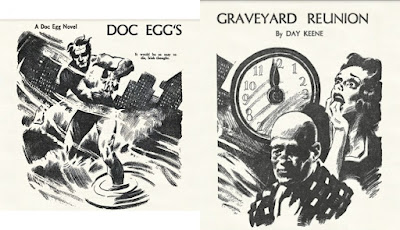In the early 1990s, twenty years after the TV series Bonanza had ended, a writer named Stephen Calder (well, actually that's a pen name for Frank Roderus and Preston Lewis) wrote a half-dozen novels set in the Bonanza universe. I've recently acquired three of them at used book stores, including The Pioneer Spirit--the first in the series.
This book picks up in the 1840s, with young Ben Cartwright serving as an officer on a merchant sailing ship. The first few chapters effectively introduce us to Ben, showing that he's already developed the rigid moral code he would have in later years and that he's already tough-as-nails. In fact, over the course of those introductory chapter, he deals with a sailor who murdered a shipmate and attempts to murder Ben. The ensuing brawl does not go well for the killer.
We learn that Ben has quite a reputation, becoming known as "The Devil of Boston" because of his accomplisments. I actually found myself wishing this book had been more focused on his career as a sailor, since some of the adventures that are merely mentioned in passing would have been pretty awesome to read about in detail. For instance, when the crew of a ship on which Ben was serving were arrested on trumped-up charges in a Central American port, Ben broke them out of jail and--to make sure the ship could escape the harbor--blew up the powder magazine in the local fort. THAT would have made a fun chapter in the book.
But the story moves on. Ben falls in love with the daughter of his captain and opens a chandler's shop in Boston. The story drags a bit while we learn how deliriously happy he is, especially after his son Adam is born. But this serves a purpose in highlighting the tragedy of his wife's death when Adam is still a toddler. Ben becomes so detached from life emotionally that he allows his business to fail and eventually decides to move west with Adam to start fresh.
The TV series covered much of this ground in a flashback episode early in its run. The details are different enough to place the events of the novel in an alternate Bonanza universe, but the author catches the strength of Ben's basic character and I can easily imagine the story of the novel as a legitimate path that eventually brings Ben to be the loving patriarch of his family and a successful rancher. He's got stuff to learn about life--particularly in dealing with loss. But he'll get there.
While heading west, he meets a Swedish woman named Inger, saving her from being beaten by her brother. They get married, though Ben does so at first to protect her and because Adam likes her. But eventually, he falls for her. Their relationship strengthens Ben to the point where, when Inger dies after the birth of Hoss, he's able to accept that life moves on after we mourn our dead. After Elizabeth died, he had allowed his sorrow to turn into self-pity. Now he has learned better.
But before he can move on with his life, he needs to survive a blizzard while alone in the mountains and separated from his sons.
Once again, the details of his marriage to Inger are different from the two flashback episodes involving her, but the personalities are spot-on. I especially like the way Adam is portrayed. As an adult, he was the most thoughtful and well-educated of the three Cartwright brothers. So, when we see him as an intelligent and perpetually curious kid, it fits perfectly.
As I said, there are a few points in which the prose drags a little. And, of course, I'm not worried about giving away spoilers because if you are reading a Bonanza novels, you know what happens to his wives. It's the beginning of the Cartwright Curse, which was the one aspect of the TV show that annoyed me. The tragedy of losing (eventually) three wives was appropriate to Ben's background. But over the course of the 14 seasons the show was on, Adam, Hoss and Little Joe each seemed to fall in love about 12, 864, 937 times apiece and the girl ALWAYS ends up dead. If you turn on a Bonanza show and they are doing a Western drama, watch it because it will be at least good and quite likely excellent. If they are doing one of their occasional comedy episodes, watch it because it will be gut-bustingly funny. If one of the Cartwrights falls in love, turn the channel and find an episode of Gunsmoke or Maverick to watch instead. The flashback episodes about Ben are an exception to this rule--those are good. But if Adam, Hoss or Little Joe falls for a gal, give up on it. It'll be filled with manipulative, treacly emotion and you know that the girl might just as well have a target pinned to her back. She's doomed.
But I digress. The Pioneer Spirit is an excellent Bonanza novel and gives us a strong and appropriate-to-the-character version of Ben's early life. It's worth reading.



















































